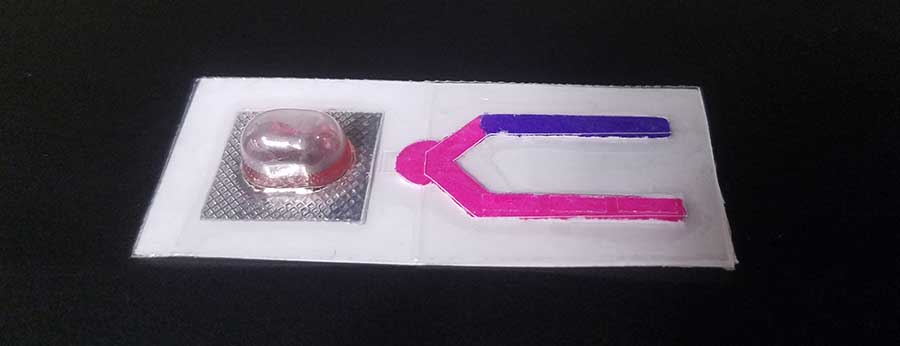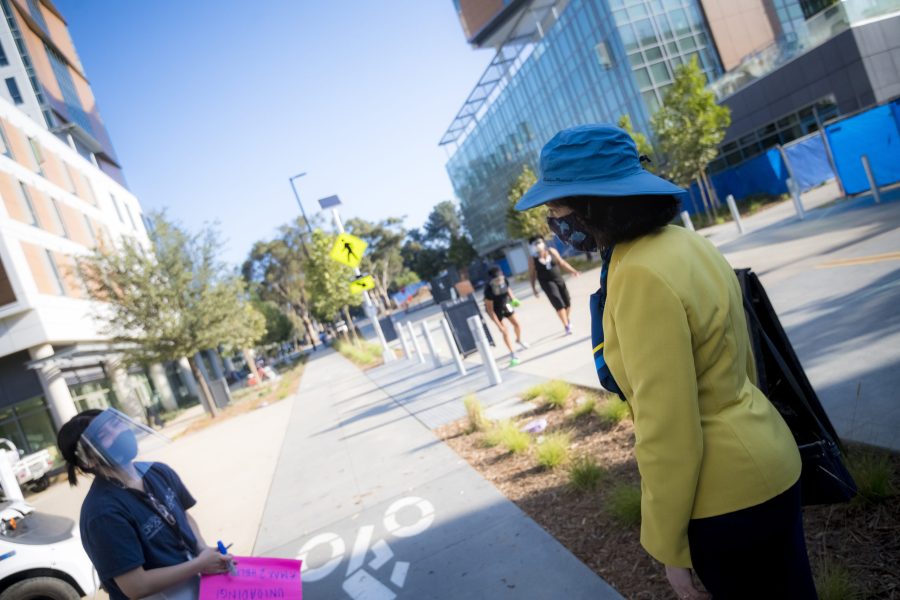UC San Diego has been awarded $1.3 million by the National Institutes of Health to develop a wearable sensor that can detect if a person has COVID-19 or has been exposed to it by someone else. The sensor will be attached to face masks to monitor for coronavirus molecules in a person’s saliva and breath. It will detect the presence of proteases, protein-cleaving molecules, that are known to be produced from the COVID-19 virus. It would also detect the virus molecules released by other people and possibly inhaled by the owner of the mask.
The plan is that particles, including COVID-19 proteases, will build up in the test strip as the user breathes through the mask. In order to identify a possible infection, the user would squeeze the blister pack on the sensor to see if it changes to a specific color. The test strip releases nanoparticles that change color in the presence of COVID-19 proteases — a control line on the strip will show what the positive result looks like. If there is a positive reading, the mask owner can take a supplementary test to confirm the result, similar to a regular covid test.
UCSD nanoengineering professor and project lead Jesse Jokerst said to The UCSD Guardian that the sensor consists of a color-changing agent, and the goal is for the product to be a sticker that they could put onto any face mask, surgical or fabric. There isn’t a specific timeline or date that this product will be available to the public or to UCSD, but they are working on making sure it is as cheap as possible.
The test strips for masks will be easily mass-produced through roll-to-roll processing, which would quickly and cheaply embed them onto face coverings. This will hopefully mean the strips will be a few cents each. Jokerst is working with UCSD School of Medicine researchers to test the strips on COVID-19-positive saliva samples and then hopefully on patients and healthcare workers at the San Diego Healthcare System.

“Currently it has been tested in artificial biomarkers, but the goal is to test the biomarker in human saliva in 90 days. Like the sewage surveillance system, the mask is a common tool so developing the sensor in the mask made the most sense,” Jokerst said to The Guardian.
This technology is just another example of the different measures that UCSD has taken to slow the spread of COVID-19, including mandating face masks, prohibiting guests in students’ rooms, and placing sensors in its wastewater system to monitor early signs of the virus. If there is a positive sign of the virus in the sewage system, UCSD emails people with information of the specific buildings so they can get tested if they used those buildings. For any positive cases, students will be moved into isolation housing.
As of Jan. 30, UCSD has had 346 students diagnosed with COVID-19, 142 living on campus and 204 living off campus in the San Diego area. As of Jan. 30, there has been one new case among students residing on campus returning after winter break. The campus did experience a surge of infections when the Winter Quarter began, however, the case number has been decreasing since then.
Although the stay-at-home order was lifted in San Diego on Jan. 25, cases remain high and there are still many restrictions in place. San Diego County remains in the purple tier, so this new technology has the potential to significantly slow the spread of COVID-19. It is important to realize that this sensor is not a replacement for social distancing, wearing masks, and attending public gatherings, or current testing protocols.
More information about this new technology can be found here.
Photo courtesy of Erik Jepsen for UC San Diego.















GBWhatsApp • Apr 11, 2021 at 8:47 am
This is going to be extremely helpful to fight against the COVID-19 disaster. I hope it ends as soon as possible. Stay Safe. Stay Indoors!
Olivia • Mar 4, 2021 at 2:55 am
Doing research, practice, all this will help us in the future. What we really need now is technology that can slow down the spread of COVID-19. I am a student and it was hard for me to come out of this state. I was afraid that I could not finish university but thanks to best coursework writing services – https://medium.com/@Frederi12472155/3-best-coursework-writing-services-available-online-2510b00009f7 I passed my term paper with flying colors.
Kelly • Feb 18, 2021 at 5:03 am
I have been assigned to prepare a medical essay, which means that I will have to spend a few days on the computer. But during that time, I could acquire the knowledge and skills that I will really need for my future profession, and the research that you wrote about. Very good article! I already think that sometimes you can order an essay, from the service professionals https://getnursingessay.com/ and do something useful.